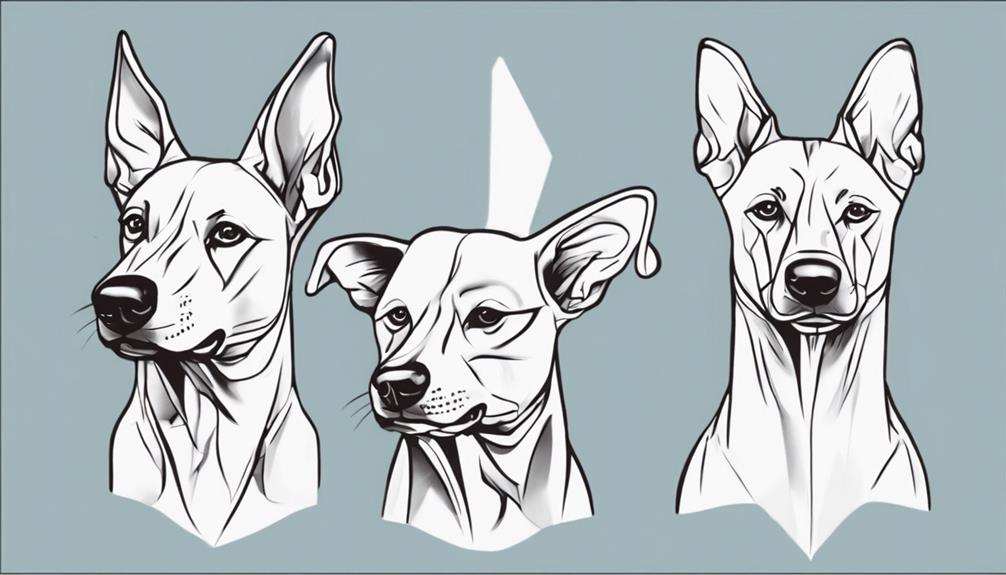Three Tips for Interpreting Your Dog's Ear Positions
When observing your furry companion, the position of their ears can speak volumes about their current state of mind. Ever wondered what those subtle ear movements really mean?
Understanding the intricacies of your dog's ear positions can provide valuable insights into their emotions and behavior. By grasping a few key tips for interpreting these cues, you may uncover a whole new level of communication with your canine friend.
Understanding Forward Ear Position
If your dog's ears are perked up and facing forward, it usually indicates attentiveness or curiosity. This type of ear language is a key component of canine communication. When your furry friend displays this behavior, they're signaling that they're alert and interested in their surroundings. This is often seen when they hear an unfamiliar noise or see something intriguing. By understanding this aspect of your dog's body language, you can better interpret their behavioral cues.
Observing your dog's ears in the forward position can provide valuable insights into their current state of mind. It signifies their engagement with the environment and their readiness to react to any stimuli. In addition to ear language, other body language signs such as a straight posture or focused gaze can further confirm their heightened state of awareness. Paying attention to these subtle cues can enhance your bond with your dog and improve your overall communication with them.
Decoding Backward Ear Placement
When your dog's ears are angled backward, it indicates a different set of emotions and intentions compared to forward ear position. This position is crucial in understanding your furry friend's state of mind. Here's what decoding backward ear placement could mean for your dog:
- Alertness: Backward ear placement can signal that your dog is alert and attentive, possibly sensing something you aren't aware of.
- Anxiety: This ear position may indicate feelings of anxiety or nervousness in your dog, suggesting that they may need comfort or reassurance.
- Submission: Your dog may be showing submission or deference to you or another animal in the vicinity through this ear position.
- Fear: Backward ear placement can also be a sign of fear or discomfort, showing that your dog is wary of a situation or object.
Understanding these communication signals and body language clues can help you respond appropriately to your dog's needs and emotions.
Analyzing One Ear Up
One ear up on your dog can indicate a heightened sense of curiosity or alertness. When you notice this ear position, it's essential to pay attention to your dog's surroundings and what might be capturing their interest.
Sometimes, a sudden noise or movement can cause your dog to perk up one ear to better focus on the source of the stimulus. This behavior is part of your dog's communication signals, showing that they're actively engaged with their environment.
If your dog typically keeps both ears in a relaxed position and suddenly raises one, it could signify that something has piqued their curiosity or raised their level of alertness. While this behavior isn't necessarily unusual, it's worth noting the specific circumstances that led to this change in ear position.
Interpreting Both Ears Down
As your dog's ears both hang down, this posture may indicate a sense of relaxation or contentment. When both ears are down, your furry friend might be feeling at ease and cozy. However, it's essential to consider other body language cues to get a more accurate understanding of your dog's emotions.
Here are some key points to consider when interpreting both ears down:
- Submissive Behavior: Drooping ears can be a sign of submission in dogs. Your pet may be showing deference to you or another dominant figure in their environment.
- Relaxed Body Language: Along with ears down, look for other signs of relaxation such as a loose body posture and a wagging tail.
- Anxiety or Discomfort: While ears down can indicate contentment, it could also signal anxiety or discomfort in certain situations. Pay attention to your dog's overall demeanor to differentiate between these emotions.
- Need for Comfort: Your dog may be seeking comfort or reassurance when their ears are down. Providing a safe and secure environment can help alleviate any stress they may be experiencing.
Significance of Ears to the Side
With ears positioned to the side, your dog may be signaling alertness or curiosity in their surroundings. This body language indicates that your furry friend is actively engaged and paying close attention to what's happening around them. When a dog's ears are to the side, it can suggest a sense of readiness for potential social interaction or exploration. Your dog is likely observing their environment and processing information, showing interest in what's happening.
In social settings, such as at the park or during a walk, ears to the side can demonstrate your dog's openness to interacting with other dogs or people. This position may indicate that they're approachable and interested in engaging with their surroundings. Understanding this aspect of your dog's body language can help you gauge their comfort level and willingness to participate in social activities. Keep an eye on your dog's ears to the side as a cue for their current state of alertness and curiosity in social interactions.
Implications of Ears Pinned Back
When a dog pins their ears back, it typically signifies a state of discomfort or submission in various situations. This ear position is crucial in understanding fear and aggression in dogs. Here are some key points to consider:
- Fear: Ears pinned back can indicate that your dog is feeling fearful or anxious. It's essential to identify the source of fear to address the issue effectively.
- Submission: In some cases, dogs pin their ears back as a sign of submission. This behavior is often seen when they encounter a dominant or unfamiliar dog.
- Aggression: Interestingly, ears pinned back can also be a sign of aggression in certain situations. Some dogs may flatten their ears when they're feeling threatened or preparing to defend themselves.
- Body Language: When you notice your dog's ears pinned back, it's crucial to observe their overall body language to interpret their emotions accurately. Combining ear position with other cues can provide a more comprehensive understanding of your dog's state of mind.
Recognizing Ear Movements

To better understand your dog's emotions and intentions, pay close attention to the subtle movements of their ears. Dogs use ear language as a vital part of their canine communication. By recognizing and interpreting these ear movements, you can gain valuable insights into your furry friend's state of mind.
When your dog's ears are perked up and facing forward, they're likely alert and interested in their surroundings. This indicates curiosity and readiness to engage. On the other hand, ears flattened against the head may suggest fear, anxiety, or submission. It's essential to observe the context in which these movements occur to accurately decipher their meaning.
Moreover, dogs may rotate or twitch their ears to different angles depending on their emotional state. Playfulness, aggression, or relaxation can all be conveyed through these subtle adjustments. By honing in on these details and considering them within the broader context of your dog's body language, you can enhance your understanding of their feelings and improve your communication with them.
Dog Ear Positions and Emotions
By observing your dog's ear positions, you can gain valuable insights into their emotions and mental state. Understanding your dog's ear language can help you connect with them on a deeper level and respond appropriately to their needs.
Here are a few key points to consider when interpreting your dog's ear positions in relation to their emotions:
- Forward ears: Indicate alertness and curiosity. Your dog is likely focused and engaged with their surroundings.
- Pinned back ears: Signal fear, anxiety, or submission. Your dog may be feeling threatened or uncomfortable in a situation.
- One ear up, one ear down: Reflect uncertainty or indecision. Your dog may be unsure about how to react to a particular stimulus.
- Relaxed, floppy ears: Show contentment and relaxation. Your dog is likely feeling comfortable and at ease in their environment.
Frequently Asked Questions
Can a Dog's Ear Position Be Influenced by Their Breed or Size?
Yes, a dog's ear position can be influenced by their breed and size. Genetic factors play a role in determining the shape and position of a dog's ears. Breeds like Cocker Spaniels often have long, floppy ears, while smaller breeds like Chihuahuas tend to have erect ears.
Additionally, environmental factors like diet and exercise can impact the muscle tone in a dog's ears, affecting how they hold them.
How Does a Dog's Age Play a Role in Their Ear Positions?
As your dog ages, their ear positions can change along with developmental milestones and behavioral shifts. Younger dogs may use their ears more prominently for socialization and communication signals.
As they grow older, the way they hold their ears could indicate different messages or emotions. Be observant of these changes to better understand your furry friend's feelings and needs as they mature.
Are There Any Medical Conditions That Could Cause Changes in a Dog's Ear Positions?
Medical conditions can indeed cause changes in your dog's ear positions. Genetics can play a role, like with floppy ears in certain breeds. Nutrition can also impact ear health, with deficiencies potentially leading to issues.
Keep an eye on any changes in your pup's ear positions and consult your vet if you notice anything unusual. Regular check-ups and a balanced diet can help maintain your dog's ear health.
Do Certain Environments or Situations Affect a Dog's Ear Positions More Than Others?
In different environments or situations, your dog's ear positions can change as a form of body language and communication. Social interactions and stress levels play a significant role in how your dog expresses emotions through their ears.
Being aware of these cues can help you understand your furry friend better and strengthen your bond. Keep an eye on their ear movements for insights into how they're feeling and what they may need from you.
Can Training or Behavior Modification Techniques Help Improve a Dog's Ear Positions?
Training methods and behavior modification can indeed help improve your dog's ear positions. By understanding communication cues and body language, you can teach your furry friend to adjust their ear positions in various situations.
Consistent training and positive reinforcement techniques can encourage desired behaviors and help your dog feel more comfortable expressing themselves through their ear movements. With patience and practice, you can enhance your pup's ability to communicate effectively through their ears.
Conclusion
So next time you're trying to understand what your furry friend is feeling, pay attention to their ear positions. Whether they're forward, backward, up, down, to the side, or pinned back, your dog's ears can tell you a lot about their emotions.
By recognizing these subtle cues, you can better communicate with and care for your beloved pup. Happy interpreting!
